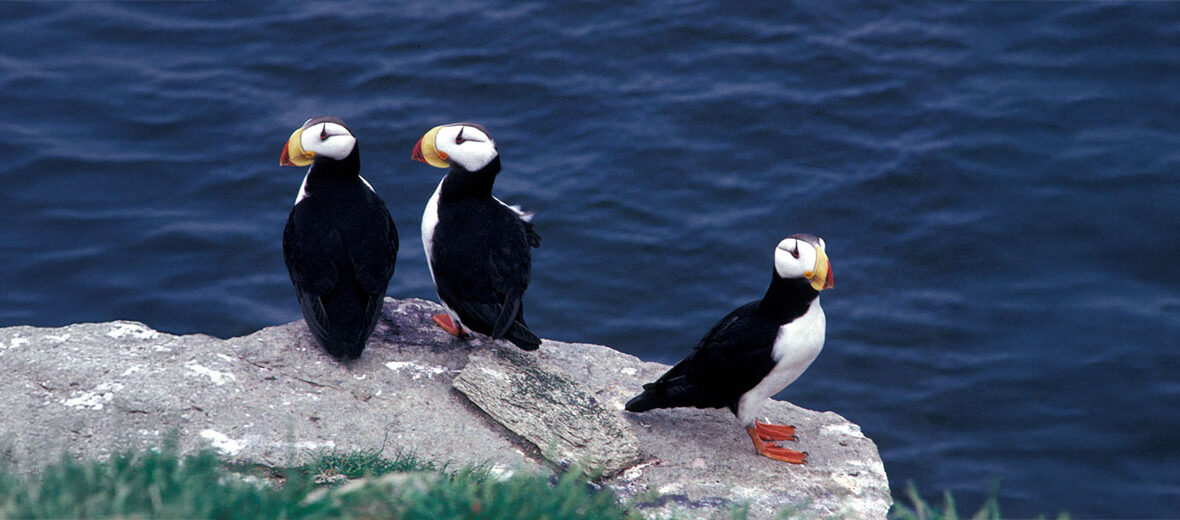
The horned puffin is a pelagic seabird that is part of the auk family. They can be found in the north Pacific Ocean off the coasts of Russian Asia, Japan, Canada, and the United States. They nest in large colonies, often with other auk species. Although abundant, these birds do face the threats of overfishing, and invasive species that can result in predation. These auks are listed as Least Concern by the IUCN. But their population trend is documented as decreasing. There are approximately 1,200,000 horned puffins, to date.
First the Stats…
Scientific name: Fratercula corniculata
Weight: Up to 18 ounces
Length: Up to 8 inches
Wingspan: Up to 23 inches
Lifespan: Up to 36 years
Now on to the Facts!
1.) They get their name due to the horn of black skin located above the eyes that is present in adults.
2.) The binomial name, Fratercula corniculata, hails from the Medieval Latin fratercula, meaning “friar”, with their black-and-white plumage resembling a monk’s robe. Corniculata translates to “horn-shaped” or “crescent-shaped”, and is in reference to the black horn above their eyes.
3.) The Yup’ik from the Yukon–Kuskokwim Delta call puffins “qilangaq”, “qengacuar(aq)” (“little nose”), or “qategarpak” (“large white breast”). The Ainu people from Sakhalin call them “etupirka”, which translates to “beautiful beak”.
4.) Horned puffins are monomorphic, which means males and females exhibit the same plumage coloration.
5.) The brightly colored outer layers of the rhamphotheca (beak) are shed in late summer, as the face reverts to a gray and black color, and the legs and feet begin to fade to a pale fleshy color. This phase is coined as eclipse plumage.
But wait, there’s more on the horned puffin!
6.) The relatively few sounds these birds produce are coos, grunts, and roars. The most common sound is an “arr-arr-arr”, which increases in speed when the they are threatened to a “A-gaa-kah-kha-kha”. To put their common call into perspective, it is like that of a distant sound of a chainsaw.
7.) During mating season, their primary call is a “Op-op-op-op-op” sound.
Did you know…?
Puffins are able to see ultraviolet rays, which allows them to see the fluorescent luminescence on the bills of other puffins during their courtship display.
8.) These birds prefer steep rocky slopes & cliff habitats and utilize the rock crevices for hiding.
9.) In order to gain flight, horned puffins will either jump off a cliff to gain momentum, or race across the water to reach the speed required for takeoff.
10.) They fly in groups of 2 – 15 individuals, traveling between foraging and nesting grounds, sometimes with tufted puffins or murres.
But wait, there’s still more on the horned puffin!
11.) Nesting colonies can contain tens to thousands of individuals.
12.) The sign of submission is to temporarily position their legs slightly apart and spread their wings over their head for about 4 seconds.
Did you know…?
These birds can dive for over 1 minute at a time.
13.) The dominant display is shown by holding one’s beak open with its tongue lowered, aka gaping, with back feathers erect, stepping in place as it rocks from side to side.
14.) When battling, puffins will lock bills and beat each other with their wings, and the 2 rivals sometimes tumble down a slope or cliff while still locked in battle.
15.) Spending nearly half their lives on the water, they paddle on the surface with their feet. While underwater, they are so graceful at swimming that this behavior has been described as underwater flight, rather than swimming.
But wait, there’s still a little more on the horned puffin!
16.) Like many other seabirds, puffins have waterproof plumage, which allows them to dive and prevents rapid heat loss. This is accomplished by their feather disposition and a specialized gland near the tail called the uropygial gland. This gland secretes a greasy and hydrophobic liquid that the puffin spreads on its plumage with its beak, allowing it to float and repel water.
17.) Fish, small invertebrates, crustaceans, polychaete worms, squid, and various algae & marine plants are all on the menu.
Did you know…?
The increased ocean temperatures have exponentiated the reproductive rate of horned puffins.
18.) Puffins are diurnal (active during the day).
19.) Horned puffins are monogamous (mate for life).
20.) Females lay a single egg that hatches in up to 41 days.
But wait, there’s still a tad more on the horned puffin!
21.) The chick, aka puffling, fledges in up to 40 days, and leaves the nest at night for the ocean to begin its life.
22.) In Alaska, nearly 250,000 puffins are distributed into 608 different colonies, the largest colony being on Suklik Island.
23.) Their populations consist of approximately 300,000 in Asia and about 900,000 in North America.
Now a Short Horned Puffin Video!
Be sure to share & comment below! Also, check out the Critter Science YouTube channel. Videos added regularly!
Want to suggest a critter for me to write about? Let me know here.
Some source material acquired from: Wikipedia & IUCN
Photo credit: U.S. Fish and Wildlife Service




